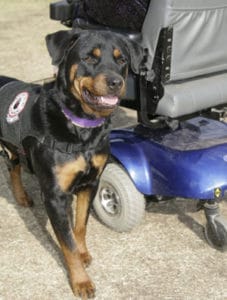
According to the United States Department of Agriculture, service dogs originated in 1920s Germany, where guide dogs were first used to help blind World War I veterans. In 1929, The Seeing Eye® guide dog school opened in the United States, the first of its kind.
Now, nearly a century later, there are over 20,000 service dogs in America. These animals do a wide range of tasks, which are defined in the Americans with Disabilities Act (ADA):
“…dogs that are individually trained to do work or perform tasks for people with disabilities. Examples of such work or tasks include guiding people who are blind, alerting people who are deaf, pulling a wheelchair, alerting and protecting a person who is having a seizure, reminding a person with mental illness to take prescribed medications, calming a person with Post Traumatic Stress Disorder (PTSD) during an anxiety attack, or performing other duties. Service animals are working animals, not pets. The work or task a dog has been trained to provide must be directly related to the person’s disability.”
Qualifying. While the ADA includes guide and hearing dogs in this definition, along with PTSD and mental illness service dogs, the policy becomes problematic because of this sentence: “Dogs whose sole function is to provide comfort or emotional support do not qualify as service animals under the ADA.”
Donna Fournier, CPDT-KA, CAB, CGC Evaluator and Director of Training at Stiggy’s Dogs, an organization that trains Psychiatric Service Dogs (PSDs), explains that main function of these dogs is maintaining their handler’s emotional state. They can be used to treat not only PTSD, but anxiety disorder, agoraphobia, and autism, among other psychological disorders.
Many of these dogs perform more than just emotional support. “Though [emotional support] is their main function, these dogs can also pull double duty; serving as seizure alert dogs, TBI [traumatic brain injury] dogs, and provide mobility needs,” Fournier adds.
“These dogs help navigate through crowded situations (one of the most stressful things for our guys), find exits quickly, bring medications and provide medication reminders at specific times, watch their [handler’s] back, provide personal space around strangers, wake from night terrors, and provide tactile stimulation (hugs and kisses, deep pressure application, licking hands to bring back to reality),” noting that these are just a few tasks that these dogs can be taught.
Does the ADA consider a dog that licks its owner in response to an emotional state a service dog or not? The policies as written leave a lot to be interpreted by those enforcing them, including various public places.
Access. Some public places, such as buses, airlines, and housing, have their own policies, which supersede the ADA. Both the Department of Transportation and the Department of Housing and Urban Development consider dogs used solely for emotional support as service dogs protected under their policies. In this case, where the superseding policy is for emotional support, it seems everyone wins.
However, the United States Army, which is not under the jurisdiction of the ADA, is working on a new policy that some fear is too restrictive when it comes to service dogs. According to the Department of Defense, the policy (issued in January 2012), was created by the Army Medical Command (MEDCOM) as an “advisory” to Army commanders, who currently make individual decisions regarding service animals.
This current system appears to be highly subjective, so it makes sense that the Army is thinking of creating an overall policy that everyone follows across the board. However, the Army is getting a lot of backlash over the MEDCOM policy, because it stipulates that service members who want a service dog must apply before a committee (rather than just their personal care physician) and, if approved, receive their dog from one of two organizations — International Guide Dog Federation (IGDF) for guide dogs for the blind, and organizations accredited by Assistance Dogs International (ADI) for all other service dogs.
Violations. Many see this is as a violation of service members’ rights because it will slow down the process of getting a dog, which in the case of suicidal patients might mean the difference between life and death. In addition, the ADA rules say “no person, organization, or governing body can stipulate where a disabled person gets their service dogs…”
As mentioned, the US Army isn’t under the ADA guidelines, most likely because military bases are not “public places” as the ADA policy stipulates. Still, many think that in this case, the Army should be held to the ADA standards.
Regardless of whether the person wanting or owning an assistance dog is a service member or not, there is still a lot of gray area when it comes to their rights. With emotional service dogs on the rise and more research being done on their effectiveness, it is more than likely that other organizations will join the Army in looking at changing policies, to make them clearer, and to ensure that they protect people’s rights.
What’s your take on the controversy over therapy dogs? Tell us in the comments.










